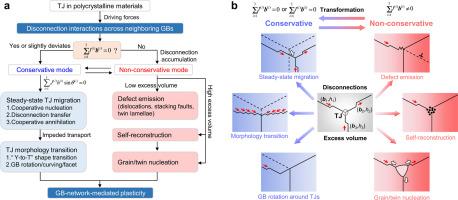三结动力学:统一原子机制与协调晶界网络演化
IF 14.3
1区 材料科学
Q1 MATERIALS SCIENCE, MULTIDISCIPLINARY
引用次数: 0
摘要
三联结(TJs)作为连接相邻晶界(GBs)的重要组成部分,在热力学刺激下控制着多晶材料中整个晶界网络的协调演化。尽管经过了几十年的研究,对TJ动力学及其对协同GB网络演化的贡献的全面理解在很大程度上仍然难以捉摸,特别是在原子尺度的实验中。利用最先进的原位纳米制造-原子分辨率纳米力学测试,我们提供了直接证据,证明在Au和Pt多晶体中,通过相邻GBs之间的保守/非保守断开活动,可以发生多种模式的TJ动力学。TJ动力学可以在保守和非保守模式之间相互转换,对于提高整个GB网络的变形柔性和保持塑性具有重要意义。通过考虑GB塑性、晶内塑性和TJ过量体积之间的耦合关系,进一步建立了统一的TJ动力学框架。这些发现适用于非同轴gb的一般tj,为理解多晶材料的塑性提供了缺失的基石。本文章由计算机程序翻译,如有差异,请以英文原文为准。

Triple junction kinetics: Unified atomic mechanism and coordinated grain boundary network evolution
Triple junctions (TJs), as essential components connecting adjoining grain boundaries (GBs), govern the coordinated evolution of the entire GB network in polycrystalline materials under thermomechanical stimulations. Despite decades of research, a comprehensive understanding of TJ kinetics and their contributions to coordinated GB network evolution remains largely elusive, especially in experiments at the atomic scale. Using state-of-the-art in situ nanofabrication-nanomechanical testing with atomic resolution, we present direct evidence that multiple modes of TJ kinetics occur through conservative/non-conservative disconnection activities across neighboring GBs in Au and Pt polycrystals. TJ kinetics can transform mutually between conservative and non-conservative modes, holding significance for enhancing the deformation flexibility and sustaining plasticity of the overall GB network. A unified framework of TJ kinetics is further established by considering the coupling between GB plasticity, intragranular plasticity, and TJ excess volume. These findings are applicable to general TJs with non-coaxial GBs, providing a missing cornerstone for understanding the plasticity of polycrystalline materials.
求助全文
通过发布文献求助,成功后即可免费获取论文全文。
去求助
来源期刊

Journal of Materials Science & Technology
工程技术-材料科学:综合
CiteScore
20.00
自引率
11.00%
发文量
995
审稿时长
13 days
期刊介绍:
Journal of Materials Science & Technology strives to promote global collaboration in the field of materials science and technology. It primarily publishes original research papers, invited review articles, letters, research notes, and summaries of scientific achievements. The journal covers a wide range of materials science and technology topics, including metallic materials, inorganic nonmetallic materials, and composite materials.
 求助内容:
求助内容: 应助结果提醒方式:
应助结果提醒方式:


